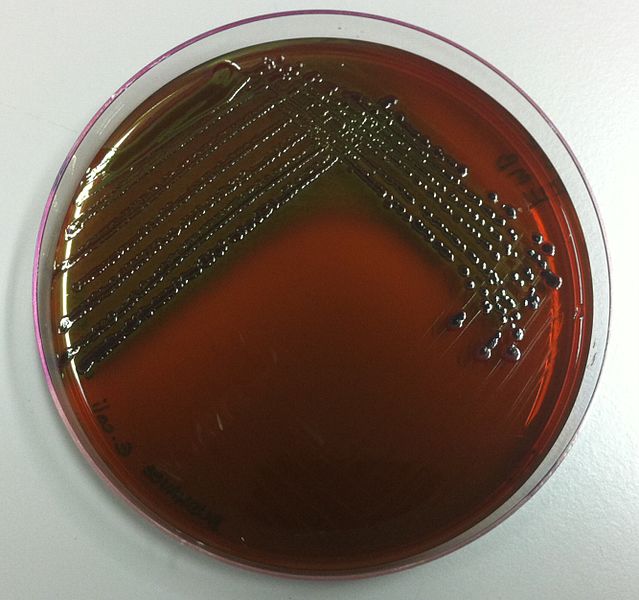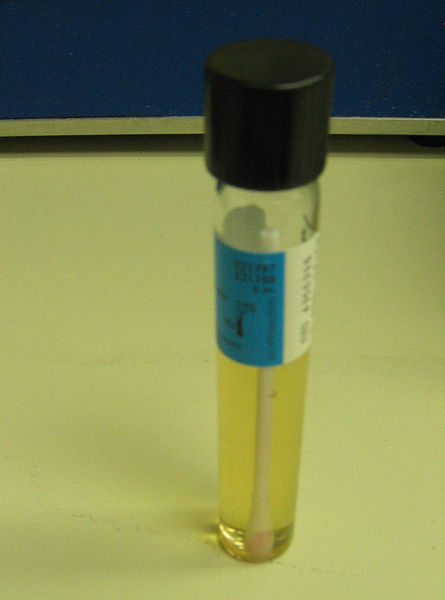The key difference between solid and liquid media is that solid media contain agar while liquid media do not contain agar. That is, agar is a solidification agent in growth media, and solid media contain a solidifying agent while liquid media lack a solidifying agent. Further to this, related to usage, the difference between solid and liquid media is that the solid media are used for isolating bacteria or for determining the colony characteristics of the microorganisms. But, liquid media are used for various purposes such as propagation of a large number of organisms, fermentation studies, and various other tests.
Microorganisms are cultivated and maintained in microbiological laboratories for various purposes. Growth requirements of the microorganisms are fulfilled by means of a growing medium, in order to obtain a sufficient growth. A growth medium or a culture medium is defined as the solid or liquid formulation which contains the nutrients and other necessary materials to support the growth of microorganisms and cells. Growth media can be either solid or liquid preparations.
CONTENTS
1. Overview and Key Difference
2. What are Solid Media
3. What are Liquid Media
4. Side by Side Comparison – Solid vs Liquid Media in Tabular Form
6. Summary
Growth media are designed according to the growth requirements of the microorganisms and the purpose of growing microbes on media. Culture media contain necessary nutrients the other ingredients required for microorganisms. Various types of culture media are available. Most culture media are prepared as solid formulations by adding a solidification agent (agar) generally at the concentration of 1.5%. Agar is a jelly-like substance which is used to solidify the medium. It is an inert substance which does not have a nutritional value. Agar is extracted from several species of red algae. The commercial agar is derived mainly from Gelidium red algae. Solid medium is a mixture of agar and other nutrients. When agar is added, the medium becomes solid at room temperature.
Solid media are generally poured into petri dishes to prepare agar plates. An agar plate provides a good surface and space to aerobic microorganisms, especially bacteria and fungi, to grow well. These agar plates with microorganisms can be used to study their characteristics. Microbes which are supposed to be used for staining techniques are grown in solid media on plates. Morphological characteristics can also be observed from the microorganisms grown on agar plates. Solid media are also used to prepare agar slants to grow microorganisms for the storage purposes.

Figure 01: Solid Media
Liquid media are a type of culture media used to cultivate and maintain microorganisms. They are also referred to as culture broths. Liquid media are not supplemented with a solidifying agent. Hence, these media remain as liquids even at room temperature. Liquid media are generally poured into test tubes or culture bottles.
When bacteria are grown in broth tubes, they are separated according to the oxygen requirement. Hence, bacteria grown on broth tubes are used to differentiate bacteria based on their oxygen requirement. Bacteria which need oxygen (strict aerobes) will grow near the surface of the broth medium while bacteria which are toxic to oxygen (strict anaerobes) will grow at the bottom of the broth tube. Bacteria that can live in presence as well as in the absence of oxygen are known as facultative anaerobes, and they are found mostly at the top of the tube. Microaerophilic bacteria are found in the upper part of the broth tube, but not at the top. Aerotolerant bacteria are normally grown evenly throughout the broth tube.

Figure 02: Liquid media
Solid vs Liquid Media | |
| Solid media are a type of culture media used to cultivate microorganisms. | Liquid media are a type of culture media used to cultivate microorganisms. |
| Presence of Agar | |
| Solid media contain agar. | Liquid media do not contain agar. |
| Petri Dishes | |
| Solid media are poured into petri dishes. | Liquid media are not poured into petri dishes. |
| Uses | |
| Solid media are used for isolating bacteria or for determining the colony characteristics of the microorganisms. | Liquid media are used for various purposes such as propagation of a large number of organisms, fermentation studies, and various other tests. Eg. sugar fermentation tests,MR-VR broth |
Summary – Solid vs Liquid Media
Solid and liquid media are two types of commonly used culture media. Solid medium is prepared by adding a solidifying substance. Commonly used solidifying agents are gelatin or agar. Liquid media are not provided with a solidifying agent. Both solid and liquid media contain nutrients and other necessary substances to support the growth of microorganisms. The main difference between solid and liquid media is the presence or absence of agar or a solidifying agent.
Download PDF Version of Solid vs Liquid Media
You can download PDF version of this article and use it for offline purposes as per citation notes. Please download PDF version here Difference Between Solid and Liquid Media
References:
“Liquid Nutrient Broth Media for Growing Bacteria.” Use of Liquid Nutrient Broth Media for Growing Bacteria. N.p., n.d. Web. Available here. 21 June 2017.
Acharya, Tankeshwar, and Tankeshwar Acharya “Bacterial Culture Media: classification, types and uses.” Microbeonline. N.p., 15 Oct. 2016. Web. Available here. 21 June 2017.
Image Courtesy:
1.”EMB streak plate with E. coli” By Budhavee S.N.A – Own work (CC BY-SA 4.0) via Commons Wikimedia
2. “Thio cropped” By Bobjgalindo – Own work (GFDL) via Commons Wikimedia
ncG1vNJzZmivp6x7pbXFn5yrnZ6YsqOx07CcnqZemLyue8OinZ%2Bdopq7pLGMm5ytr5Wau26%2FzqWgnWWRo7FuwtJmo6KppZ6xbrnEnaCaZw%3D%3D